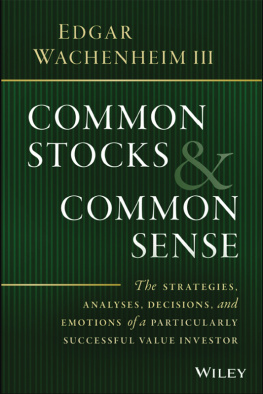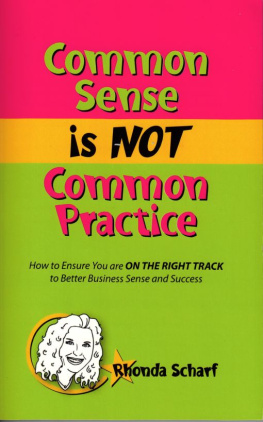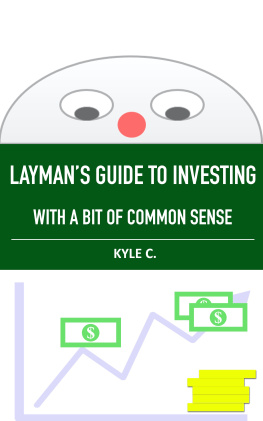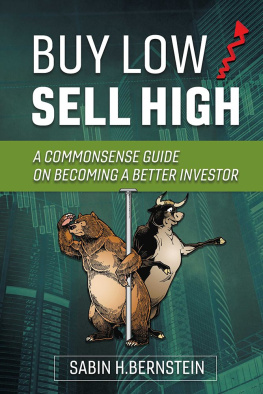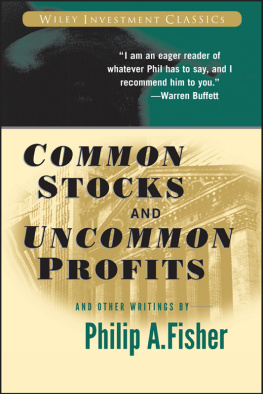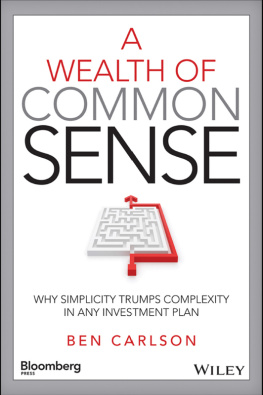
COMMON STOCKS AND COMMON SENSE
The Strategies, Analyses, Decisions, and Emotions of a Particularly Successful Value Investor
Edgar Wachenheim III
Cover design: Wiley
Copyright 2016 by Edgar Wachenheim III. All rights reserved.
Published by John Wiley & Sons, Inc., Hoboken, New Jersey.
Published simultaneously in Canada.
No part of this publication may be reproduced, stored in a retrieval system, or transmitted in any form or by any means, electronic, mechanical, photocopying, recording, scanning, or otherwise, except as permitted under Section 107 or 108 of the 1976 United States Copyright Act, without either the prior written permission of the Publisher, or authorization through payment of the appropriate per-copy fee to the Copyright Clearance Center, Inc., 222 Rosewood Drive, Danvers, MA 01923, (978) 750-8400, fax (978) 646-8600, or on the Web at www.copyright.com. Requests to the Publisher for permission should be addressed to the Permissions Department, John Wiley & Sons, Inc., 111 River Street, Hoboken, NJ 07030, (201) 748-6011, fax (201) 748-6008, or online at http://www.wiley.com/go/permissions.
Limit of Liability/Disclaimer of Warranty: While the publisher and author have used their best efforts in preparing this book, they make no representations or warranties with respect to the accuracy or completeness of the contents of this book and specifically disclaim any implied warranties of merchantability or fitness for a particular purpose. No warranty may be created or extended by sales representatives or written sales materials. The advice and strategies contained herein may not be suitable for your situation. You should consult with a professional where appropriate. Neither the publisher nor author shall be liable for any loss of profit or any other commercial damages, including but not limited to special, incidental, consequential, or other damages.
For general information on our other products and services or for technical support, please contact our Customer Care Department within the United States at (800) 762-2974, outside the United States at (317) 572-3993 or fax (317) 572-4002.
Wiley publishes in a variety of print and electronic formats and by print-on-demand. Some material included with standard print versions of this book may not be included in e-books or in print-on-demand. If this book refers to media such as a CD or DVD that is not included in the version you purchased, you may download this material at http://booksupport.wiley.com. For more information about Wiley products, visit www.wiley.com.
Library of Congress Cataloging-in-Publication Data:
ISBN 9781119259602 (Hardcover)
ISBN 9781119259626 (ePDF)
ISBN 9781119259930 (ePub)
To my loving wife, Sue, my four children,
and my six grandchildren.
After health, nothing is more important than family.
The author will donate all royalties received from sales of this book to a
charitable foundation.
INTRODUCTION
I have a passion for common stocks. For the past 30-plus years, I have studied the fundamentals of companies and industries, interviewed managements, visited offices and factories, constructed models of possible future earnings, and made thousands of decisions to purchase and sell stocks. My endeavors have been intense, exciting, fun, and successful. Thousands of other investment managers, many with higher IQs than mine, also have intensively searched for stocks that will appreciate sharply, but relatively few have been as successful as I have been. Why have I been able to succeed? There is no simple answer. If there were a simple answer, most others also would have found and adopted successful approaches to investing and would have enjoyed outsized returns. This has not happened. However, there must be reasons why some investors are better than others.
With the hope that others will benefit from my approach to investing, this book will explore what I believe to be the reasons for my relative success and will describe the reasoning behind the investment decisions that I made over the years. How will I do this? I am a product of the Harvard Business School, which teaches business via the case method. Because I believe that the case method is an interesting, relevant, and effective way to explain the strategies and thinking behind business and investment decisions, I used the method in this book. Chapters 3 through 13 in this book give an inside view of 11 investments made over the years by Greenhaven Associates, the investment management firm I founded in 1987. The explanations summarize Greenhavens actual investment process: our research, our analysis, our models, and our decisions. The explanations also try to explain the behavioral sides of being in the investment business: our emotions, aspirations, hopes, elations, disappointments. These chapters are the meat of the book and should give the reader a detailed inside view of how an investment manager spends his time and makes his decisions. Also, and importantly, the chapters should give the reader a material understanding of why I have been a successful investorof what has worked and not worked.
In order to give the reader a better understanding of the investment decisions made in Chapters 3 through 13, I have included Chapter 1, which explains Greenhavens basic approaches and strategies to investing. And because an investors success in carrying out his strategies is heavily dependent on his personality, temperament, and lifetime experiences, I have included Chapter 2 about my innate abilities and, more important, about my personality, emotions, and educational and professional experiences.
Chapter 14, the final chapter of this book, is a letter I wrote to Jack Elgart, a younger investor who asked for advice on becoming a successful investment manager. This chapter summarizes my investment strategies and lists a number of dos and donts that I found useful over the years.
When I was in my teens and 20s, my father continually advised me that it is a gift to hide ones abilitiesand my father-in-law continually counseled that one should not call attention to oneself. Why, then, did I write this book? Why the disobedience to elders whom I respected and loved? Here is why. Investing in common stocks has been my lifes work, my passion, my fun, my source of income, my source of wealth. Over the years, with hopes of becoming a better investor, I have studied hard and thought intensively about why some investment ideas have worked for me and why others have not. And I have thought about the innate abilities, experiences, creativity, and mental states of those who became successful investors, and about those who did not. As a result of these efforts, I developed the psychological and analytical approaches to investing that have been successful for me. In recent years, I developed a strong desirealmost a callingto share these approaches and experiences with others lest they be lost to time. That is why I wrote this book.
While the basic facts behind each of the described investments in this book are accurate, I have forgotten many of the details, such as exact conversations, estimates of revenues and earnings, dates, and locations. These I approximated wherever possibleor, in some cases, pulled from my imperfect memory. In addition, I have taken the liberty of changing the names and backgrounds of some individuals in order to protect their privacy. I have also revised the original letter to Jack Elgart to include additional approaches and strategies and to expand some explanations.
Next page
